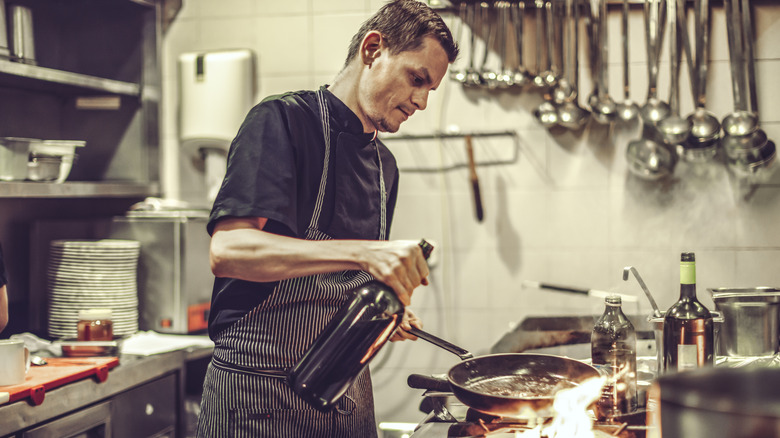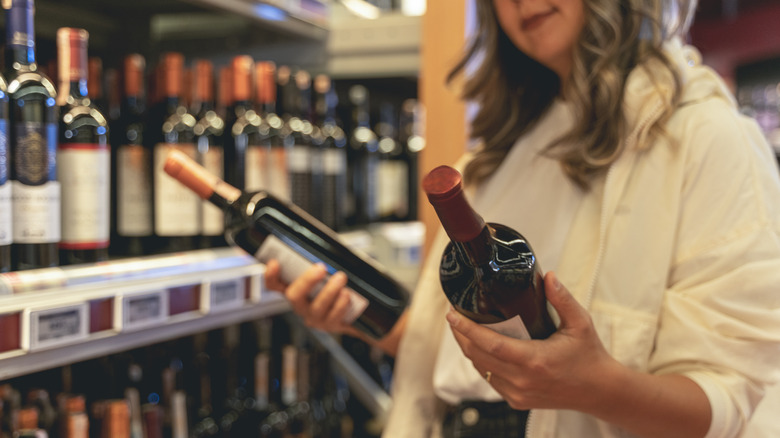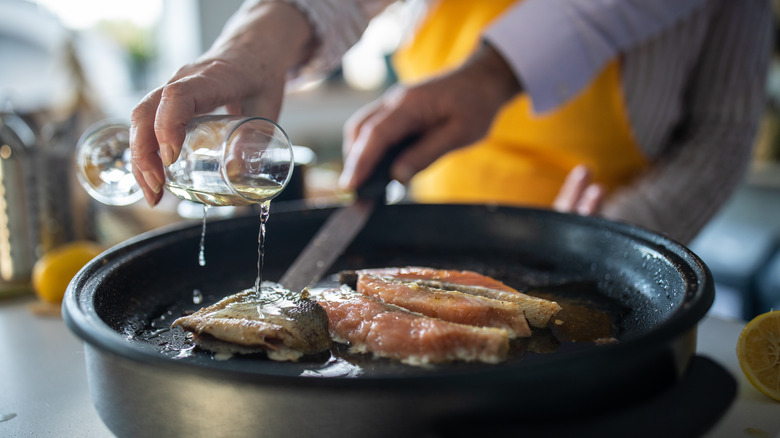The Simple Tip For When To Cook With Dry Wine Vs Sweet Wine
Cooking with wine is one of the simplest ways to boost the flavor of a dish. There's always a wine to fit someone's budget, and will definitely up your home cooking game. However, there are so many wines to choose from and so many applications that it can be overwhelming, even for a seasoned home cook. The one thing to keep in mind when choosing to cook with a dry wine versus a sweet wine is what you want your final dish to taste like.
Dry red and white wines are ideal if you're cooking a deeply savory meal, like a bolognese or a braise. Don't feel like you must use red wine for your beef braises – a dry white wine could serve to brighten the flavors with its crisp finish. You can swap your red wine for white in coq au vin for a lighter flavor.
Sweet wines are a bit more versatile, as they can be used in a variety of different dishes, from sweet to savory. But you should only use it if you aim for sweetness on the plate. As wine reduces the flavors intensify, and the sugars will be evident in the final dish. You can use a sweet wine to poach pears, steam fish or lobster, or even braise chicken.
So, the next time you're mastering your cooking techniques and aren't sure which wine to go with, taste it. Whatever flavors you taste will end up in your dish, even if it's just a whisper.
A few things to take into consideration when cooking with wine
Julia Child is famous for advocating you should only cook with a wine you'd happily drink. But there's no need to spend a lot of money on a bottle of wine you'll end up cooking with. Even a boxed wine makes a perfectly acceptable braising liquid, and no one has to know. In other words, cheap wine is fine. However, cheap wine does tend to have a higher acidity, as it spends less time aging than a more expensive wine, so keep that in mind when shopping for the wine you plan to cook with.
And finally, there will always be at least some alcohol left in the dish, even after cooking it. The more time the wine cooks, the slower evaporation is, so even after a long braise or simmer, there's still some alcohol left. So if you have guests who perhaps can't or shouldn't consume alcohol, let them know before they dig in, or opt for an easy ingredient swap like vinegar, stock, or lemon juice.
And please, never buy cooking wine at the supermarket. They tend to be full of the stuff you don't want in your food like preservatives and excess amounts of salt and sugar. There are other great substitutes, both alcoholic and non-alcoholic, that fit your budget and skill level.
Wine can add subtle flavors through a variety of applications
Reductions and pan sauces are the most common ways you'll see wine being used in recipes. Think of all those episodes of Masterchef and someone using a red wine reduction for their duck breast. The thing is, just reducing red wine does not make a pan sauce. Wine cooked on its own is rather unpleasant. It can be bitter, tart, and highly acidic, and these flavors will also be more obvious on the palate. If you're using a high-tannin dry wine like a cabernet sauvignon, be sure to temper it with meat or stock, as the tannins bind with the meat proteins, which lessens their impact. You can also use a pinch of salt, butter, or even an acid like lemon juice or Dijon mustard to tweak your red or white wine pan sauce to your liking.
If you're not making pan sauces or braising, you can use wine to poach, steam, or marinade. Wine is a great base for any of these applications, as the flavor of the wine will perfume the protein and vegetables. You can even bake with wine, as the wine makes things fluffy, moist, and delicately flavored.


